Hopi Pueblo Small Polychrome Seed Jar by Nampeyo of Hano - C3801C
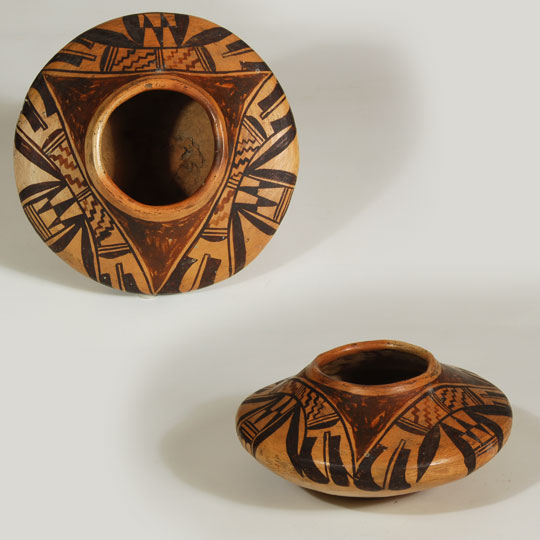 Nampeyo was handpicked by Hopi trader Thomas Keam to make pottery in the style of the prehistoric Sikyatki potters. He chose her because she was, to him, the best potter at Hopi. She never disappointed him by producing anything less than wonderful. She did not copy Sikyatki potter's work but used it as inspiration for her own designs.
Nampeyo was handpicked by Hopi trader Thomas Keam to make pottery in the style of the prehistoric Sikyatki potters. He chose her because she was, to him, the best potter at Hopi. She never disappointed him by producing anything less than wonderful. She did not copy Sikyatki potter's work but used it as inspiration for her own designs.
This small polychrome seed jar is so typical of Nampeyo's fine craftsmanship. It replicates the Sikyatki vessel shape with a wide midsection and a graceful slope upward to the rim. An unusual departure from what one normally sees on jars of this style is her use of only three red triangles rather than four. It is Nampeyo exercising her creativity.
Historic Acoma Pueblo Polychrome Wedding Vase with Documentation - SC3816D
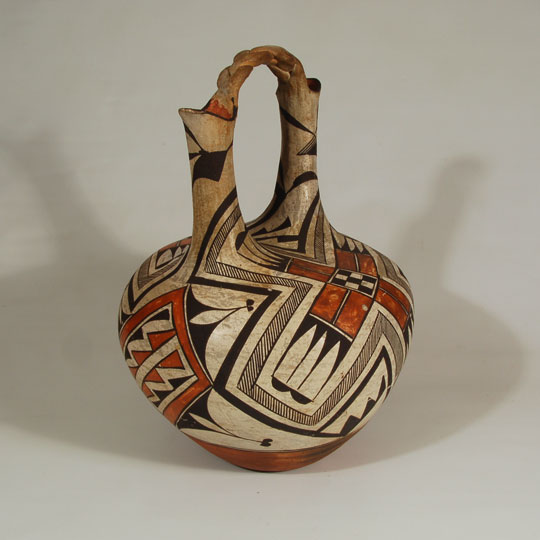 The famous Route 66 highway was a financial blessing in the 1930s for Acoma and Laguna Pueblo artisans who found it worthwhile to set up tables on the roadside to sell their wares to tourists traveling between Chicago and Los Angeles. They also sold pottery to merchants in the area, one of whom was Abdoo H. Fidel (1880-1947), a Lebanese immigrant, who set up a curio shop in San Fidel, only a few miles from Acoma Pueblo. A 1934 photograph of his shop showed over 500 Acoma pottery items on shelves, stacked atop each other, and scattered all over the floor. He obviously was a major buyer from the potters, having purchased thousands of potteries from them during the years he operated his curio shop.
The famous Route 66 highway was a financial blessing in the 1930s for Acoma and Laguna Pueblo artisans who found it worthwhile to set up tables on the roadside to sell their wares to tourists traveling between Chicago and Los Angeles. They also sold pottery to merchants in the area, one of whom was Abdoo H. Fidel (1880-1947), a Lebanese immigrant, who set up a curio shop in San Fidel, only a few miles from Acoma Pueblo. A 1934 photograph of his shop showed over 500 Acoma pottery items on shelves, stacked atop each other, and scattered all over the floor. He obviously was a major buyer from the potters, having purchased thousands of potteries from them during the years he operated his curio shop.
Historic Cochiti Pueblo Painted Hand Held Drum - 25508
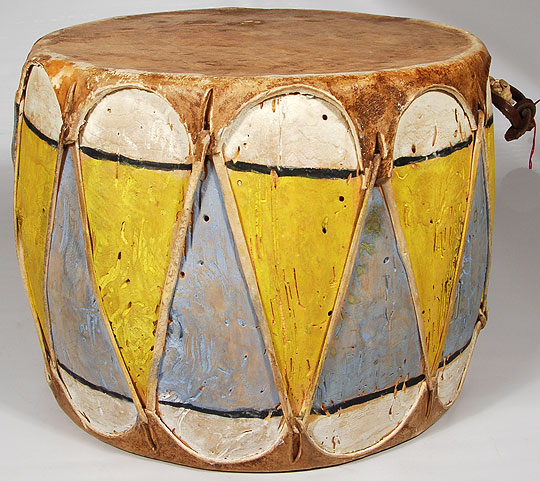 Painted and unpainted drums of all sizes are used in pueblo ceremonies. The drum suggests the thunder that comes with rain. The drum has two heads. Pueblo songs are written to start slowly and then go to a climax. At a certain point of the song, the drum is flipped over to achieve a higher beat. This lifts the dancers and gives them the impetus to continue dancing.
Painted and unpainted drums of all sizes are used in pueblo ceremonies. The drum suggests the thunder that comes with rain. The drum has two heads. Pueblo songs are written to start slowly and then go to a climax. At a certain point of the song, the drum is flipped over to achieve a higher beat. This lifts the dancers and gives them the impetus to continue dancing.
Kewa Pueblo Polychrome Pictorial Olla by Robert Tenorio - 25436
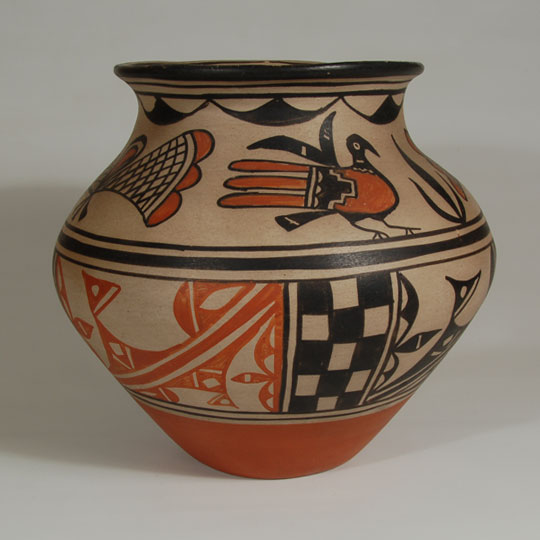 There is probably no collector of contemporary pueblo pottery who does not know Robert Tenorio or at least aware of him. He is the best-known potter from Santo Domingo Pueblo. Robert makes pottery that is as functional as pottery was a hundred years ago. He makes it for his own table use and makes functional pottery for many other pueblo residents.
There is probably no collector of contemporary pueblo pottery who does not know Robert Tenorio or at least aware of him. He is the best-known potter from Santo Domingo Pueblo. Robert makes pottery that is as functional as pottery was a hundred years ago. He makes it for his own table use and makes functional pottery for many other pueblo residents.
Robert attended the Institute of American Indian Arts (IAIA) at the time that Otellie Loloma was a teacher and it was she who convinced him to enroll in ceramics class. She enrolled him in her class and taught him different techniques, including how to make wheel-thrown stoneware pottery. Robert has made some stoneware pottery in the past. He is best known, of course, for his traditional coil-formed pueblo pottery.
Santa Clara Pueblo Red Ribbed Melon Jar by Angela Baca - C3812C
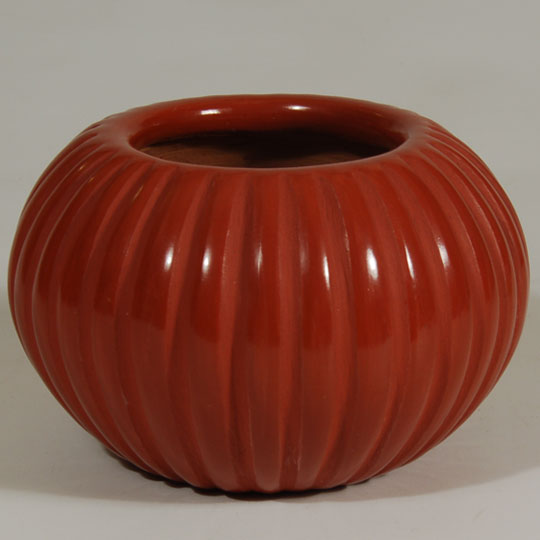 Angela Baca has long been associated with her ability to produce beautiful red and black jars with melon ribs. Works in the melon style are first coil-formed with a large diameter coil and allowed to dry to a leather-hard state. They are then carved with the distinctive ribs. After carving, the work is slipped in iron-bearing red slip, intricately stone-polished and then fired in either a smothered, reduction atmosphere to achieve the superb black finish or in an oxidizing atmosphere to achieve the red finish.
Angela Baca has long been associated with her ability to produce beautiful red and black jars with melon ribs. Works in the melon style are first coil-formed with a large diameter coil and allowed to dry to a leather-hard state. They are then carved with the distinctive ribs. After carving, the work is slipped in iron-bearing red slip, intricately stone-polished and then fired in either a smothered, reduction atmosphere to achieve the superb black finish or in an oxidizing atmosphere to achieve the red finish.
Traditional Hopi Puelbo Masha’n - Flower Katsina Doll - C3535.05
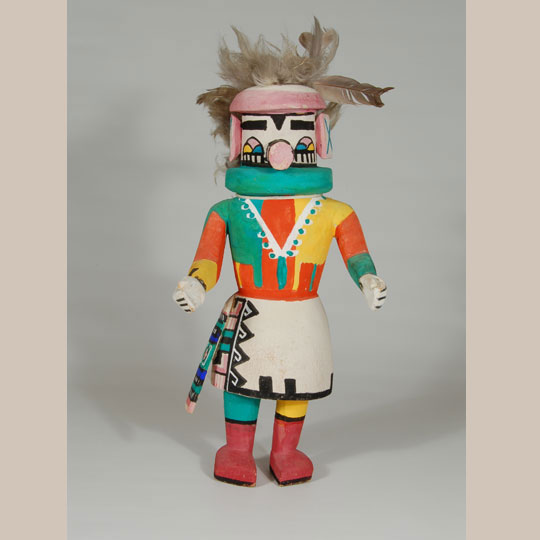 In Hopi Journal, Alexander Stephen provided an excellent accounting of spring and early summer Katsina dances that occurred in 1891 in which this katsina participated. Such dances are pleas for rain at the season of planting. There is a four-day ritual abstinence, mask preparation and prayer-stick making in the kiva before the dance commences. Dance practice and song rehearsal occur during these four days.
In Hopi Journal, Alexander Stephen provided an excellent accounting of spring and early summer Katsina dances that occurred in 1891 in which this katsina participated. Such dances are pleas for rain at the season of planting. There is a four-day ritual abstinence, mask preparation and prayer-stick making in the kiva before the dance commences. Dance practice and song rehearsal occur during these four days.
Magnificent Hopi Pueblo Pictorial Seed Jar by Mark Tahbo - 25892
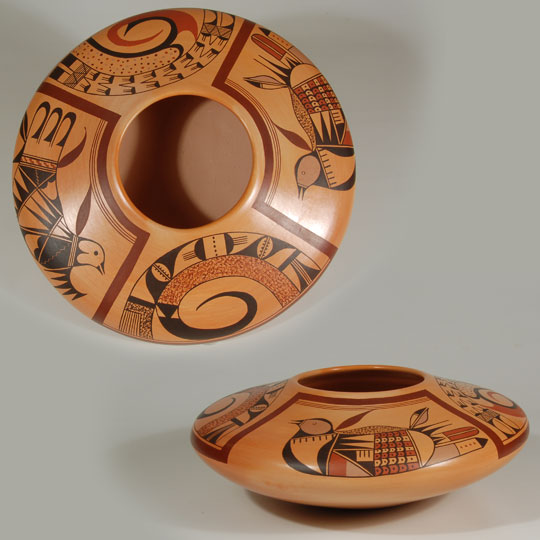 Mark Tahbo visited us again and surprised us with two innovations that were new in his artistic endeavors, but we will get to those a little later. Initially one needs only to take a look at the shape of this seed jar and admire the amazing pictorial designs on the upper portion. There are four design panels and each is different.
Mark Tahbo visited us again and surprised us with two innovations that were new in his artistic endeavors, but we will get to those a little later. Initially one needs only to take a look at the shape of this seed jar and admire the amazing pictorial designs on the upper portion. There are four design panels and each is different.
To start from the beginning, that is, the construction of the vessel, we listened to Mark explain where and why he chose the clay for this jar. Mark has always admired Garnet Pavatea and her production of pottery so he decided to visit the clay source Garnet used and to gather enough of that clay to make this jar. That clay bed is on the side of the road from the village of Polacca to the top of the mesa where Garnet lived.
Turquoise and Hieshe Nugget Necklace with Leo Poblano Fetishes - 25883
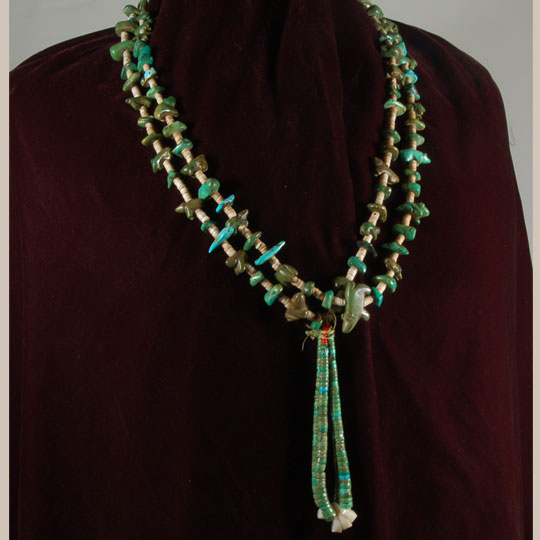 This necklace is comprised of two strands of shell hieshe interspersed with turquoise nuggets and turquoise fetishes. The fetishes have been identified as having been made by Leo Poblano. There are 30 fetishes on the necklace, some of which are bright green turquoise and some are dark green. Interspersed between the fetishes are drilled turquoise nuggets. A pair of jaclas is suspended from the necklace and the green turquoise of the jaclas compliments the green stones and fetishes of the necklace. The necklace is strung on string with a worn pueblo wrap at the neck. The necklace appears to be quite old but it is difficult to place a date on it.
This necklace is comprised of two strands of shell hieshe interspersed with turquoise nuggets and turquoise fetishes. The fetishes have been identified as having been made by Leo Poblano. There are 30 fetishes on the necklace, some of which are bright green turquoise and some are dark green. Interspersed between the fetishes are drilled turquoise nuggets. A pair of jaclas is suspended from the necklace and the green turquoise of the jaclas compliments the green stones and fetishes of the necklace. The necklace is strung on string with a worn pueblo wrap at the neck. The necklace appears to be quite old but it is difficult to place a date on it.
Black Carved Jar with Avanyu Design by Margaret Tafoya - C3812B
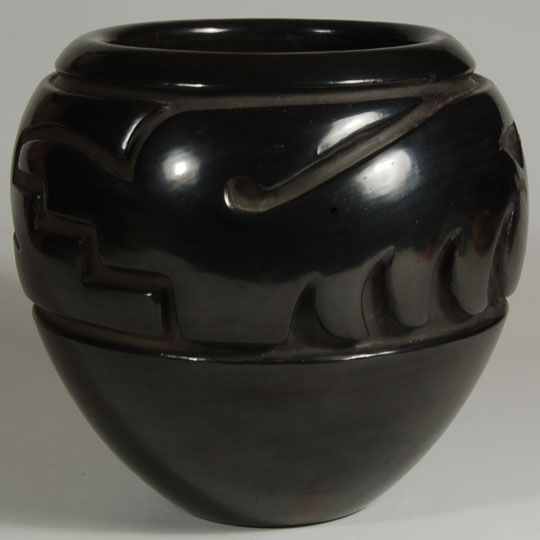 In the mid-twentieth century, Margaret Tafoya produced many very large pottery vessels and then in the 1960s-1970s, she produced many smaller vessels such as this jar. Not only was she capable of creating a beautiful vessel shape but she obtained a smooth finish and high burnish and then proceeded to execute a precise carved design.
In the mid-twentieth century, Margaret Tafoya produced many very large pottery vessels and then in the 1960s-1970s, she produced many smaller vessels such as this jar. Not only was she capable of creating a beautiful vessel shape but she obtained a smooth finish and high burnish and then proceeded to execute a precise carved design.
The design is a stylized Avanyu (water serpent) rotating in a counterclockwise direction. The small triangle is the eye of the Avanyu and the curved part of the head is the plume on the head. The four wave-like carvings are part of the serpent's body.
Painting of Multi-storied Adobe Pueblo Building by Albert Lujan - C3814B
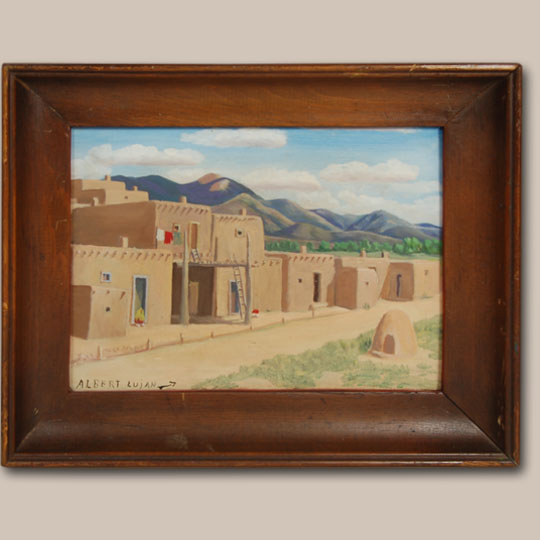 Albert Lujan was an early Taos Pueblo painter who was ahead of his time in painting European-American style art rather than the Santa Fe Indian School style being practiced by most of the other Native American artists of his time. He, along with Albert Looking Elk and Juan Mirabal, was greatly influenced by the Anglo Taos artists of the time.
Albert Lujan was an early Taos Pueblo painter who was ahead of his time in painting European-American style art rather than the Santa Fe Indian School style being practiced by most of the other Native American artists of his time. He, along with Albert Looking Elk and Juan Mirabal, was greatly influenced by the Anglo Taos artists of the time.
The work of all three artists was shunned by collectors and the Museum of New Mexico Fine Art Gallery because it was too much like that which the Taos and Santa Fe artists produced. Now they have become very collectible.
Historic Tesuque Pueblo Black-on-red Figural Vessel - C3776N
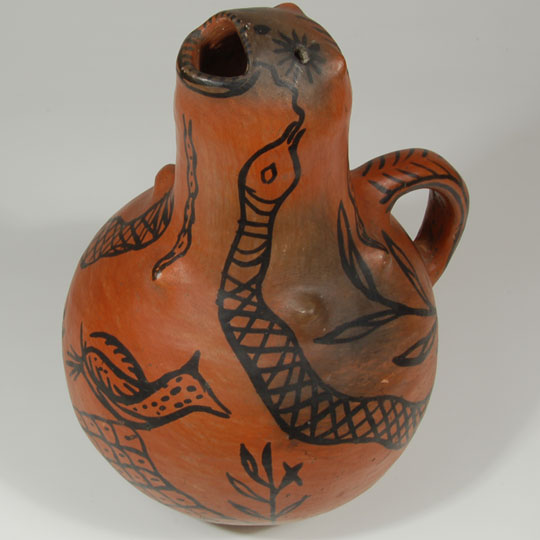 What generally comes to mind when one thinks of Tesuque Pueblo pottery are, first, Tesuque rain gods, then, secondly, garish poster paint tourist wares, and then, finally, very high quality Polychrome pottery. Potters at Tesuque were very talented and produced some truly outstanding jars and bowls. Probably the least pottery style from Tesuque, to come to mind for most collectors, would be Black-on-red Pictorial Animal Effigy Vessels. That's a long descriptive title but it accurately describes this vessel.
What generally comes to mind when one thinks of Tesuque Pueblo pottery are, first, Tesuque rain gods, then, secondly, garish poster paint tourist wares, and then, finally, very high quality Polychrome pottery. Potters at Tesuque were very talented and produced some truly outstanding jars and bowls. Probably the least pottery style from Tesuque, to come to mind for most collectors, would be Black-on-red Pictorial Animal Effigy Vessels. That's a long descriptive title but it accurately describes this vessel.
Hopi Pueblo Very Large Polychrome Seed Jar by Mark Tahbo - C3815
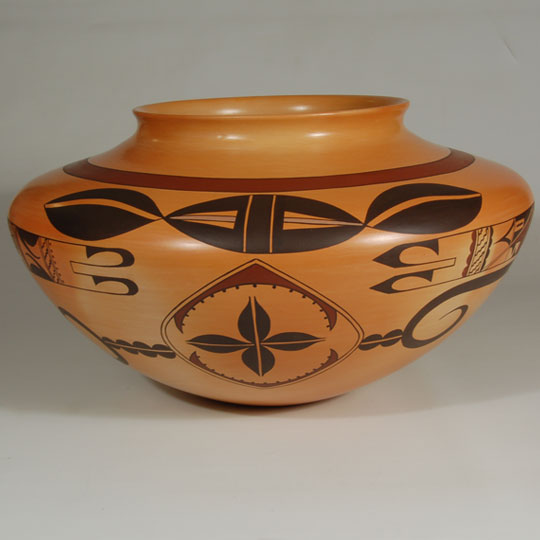 Mark Tahbo came in during Santa Fe's Indian Market season and beamed with enthusiasm when he unpacked this large and magnificent jar. He hardly knew where to start telling us what he had in mind as he made it and which elements of design he chose. He walked us through each design element and I hope I can recall all he said and pass it on in this presentation.
Mark Tahbo came in during Santa Fe's Indian Market season and beamed with enthusiasm when he unpacked this large and magnificent jar. He hardly knew where to start telling us what he had in mind as he made it and which elements of design he chose. He walked us through each design element and I hope I can recall all he said and pass it on in this presentation.
Original Painting of a Clown, Female Dancer and Drummer by Awa Tsireh - C3814A
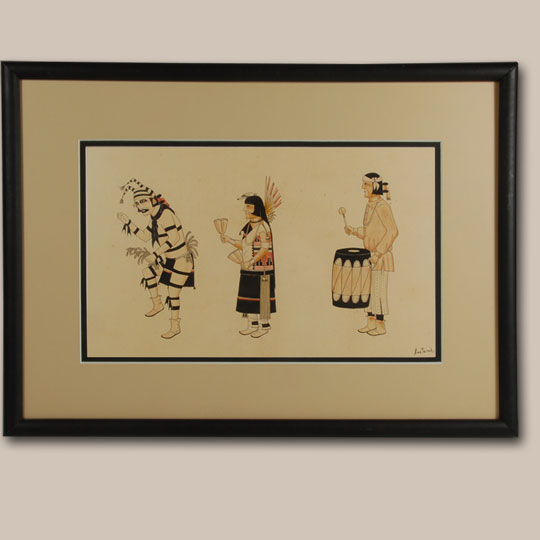 Alfonso Roybal (Awa Tsireh) was many things to his pueblo of San Ildefonso: he was a farmer, pottery painter, museum employee, painter and silversmith. He was born in 1898 and died in 1955. He was painting before 1917. He was the oldest of the early group of pueblo painters. His formal education had not extended beyond primary grades. He was versatile in his styles of painting. He was equally comfortable with representational, semi-realistic, conventional, and abstract.
Alfonso Roybal (Awa Tsireh) was many things to his pueblo of San Ildefonso: he was a farmer, pottery painter, museum employee, painter and silversmith. He was born in 1898 and died in 1955. He was painting before 1917. He was the oldest of the early group of pueblo painters. His formal education had not extended beyond primary grades. He was versatile in his styles of painting. He was equally comfortable with representational, semi-realistic, conventional, and abstract.
Small Polychrome Hopi Pueblo Jar by Nampeyo of Hano - C3801B
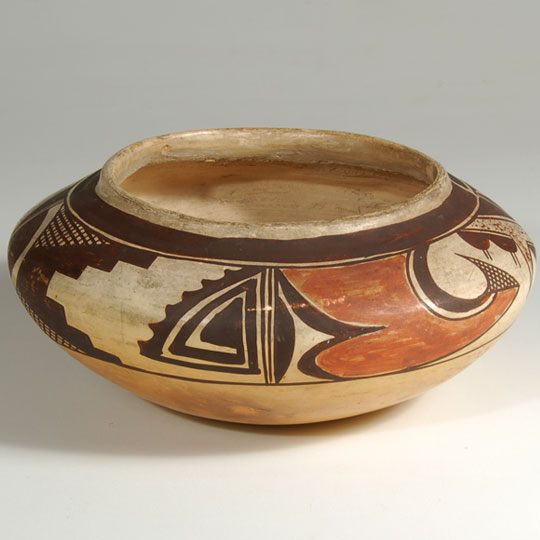 It was around 1880 when the transcontinental train passed through the Southwest. The Atchison Topeka and Santa Fe Railway teamed up with The Fred Harvey Company to enthusiastically promote the native cultures and the artists of Taos and Santa Fe. They also heavily promoted the Hopi, primarily because of the semi-annual Snake Dance ceremony. They must be given credit for changing America's attitude toward its native cultures, particularly in the Southwest.
It was around 1880 when the transcontinental train passed through the Southwest. The Atchison Topeka and Santa Fe Railway teamed up with The Fred Harvey Company to enthusiastically promote the native cultures and the artists of Taos and Santa Fe. They also heavily promoted the Hopi, primarily because of the semi-annual Snake Dance ceremony. They must be given credit for changing America's attitude toward its native cultures, particularly in the Southwest.
Dark Green Turquoise and Sterling Silver Navajo Ring - 25887
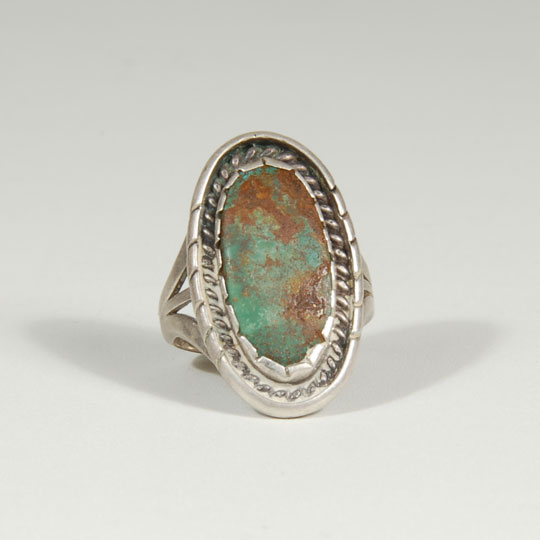 This very dainty silver framework holds a significantly beautiful very dark turquoise stone that has a beautiful copper color matrix interspersed within the turquoise stone. The turquoise is held in place with a silver bezel that is scored every eighth inch. In the shadow box surrounding the turquoise are raised silver dots. The outer rim of the silver top is scored on the edges.
This very dainty silver framework holds a significantly beautiful very dark turquoise stone that has a beautiful copper color matrix interspersed within the turquoise stone. The turquoise is held in place with a silver bezel that is scored every eighth inch. In the shadow box surrounding the turquoise are raised silver dots. The outer rim of the silver top is scored on the edges.
Kewa - Santo Domingo Depression Era Earrings - 25891
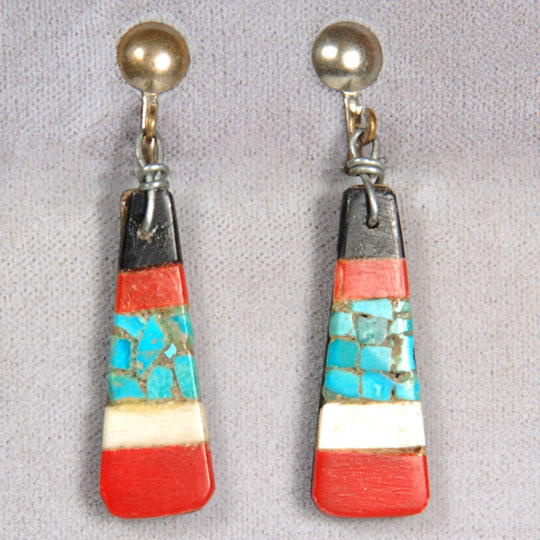 Santo Domingo Pueblo is located between Albuquerque and Santa Fe along the Camino Real, the old trade road between Mexico and Santa Fe. The people of Santo Domingo, now referred to as Kewa Pueblo, traditionally have been known as great traders. During the Depression, when the economy prevented them from being able to purchase high grade materials, the artists of Santo Domingo used less expensive materials to create jewelry to sell to tourists.
Santo Domingo Pueblo is located between Albuquerque and Santa Fe along the Camino Real, the old trade road between Mexico and Santa Fe. The people of Santo Domingo, now referred to as Kewa Pueblo, traditionally have been known as great traders. During the Depression, when the economy prevented them from being able to purchase high grade materials, the artists of Santo Domingo used less expensive materials to create jewelry to sell to tourists.
Navajo Oval Shape Cluster Silver and Turquoise Ring - 25886
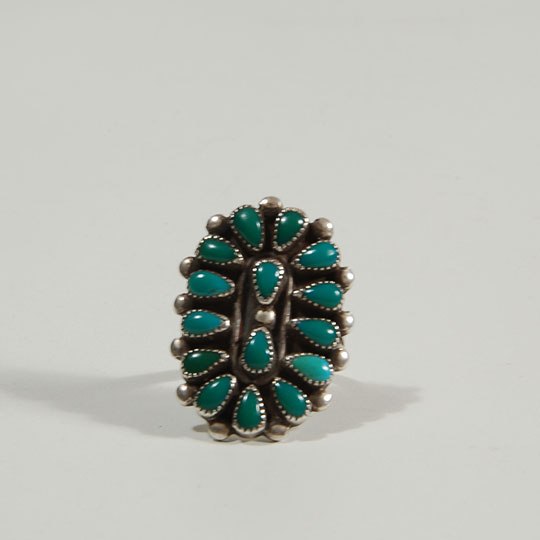 For their own use, many Navajo prefer jewelry arranged in cluster form. Large cluster bracelets are often seen on Navajo women at powwows and walking around Gallup, New Mexico. Cluster rings also share in this popularity.
For their own use, many Navajo prefer jewelry arranged in cluster form. Large cluster bracelets are often seen on Navajo women at powwows and walking around Gallup, New Mexico. Cluster rings also share in this popularity.
This cluster ring has 15 tear-drop shaped blue and green turquoise cabs arranged on an oval silver backing. This ring is probably no more recent that the 1950s. All of the turquoise stones are in excellent condition.
Navajo Silver and Turquoise Very Old Bracelet - 25884
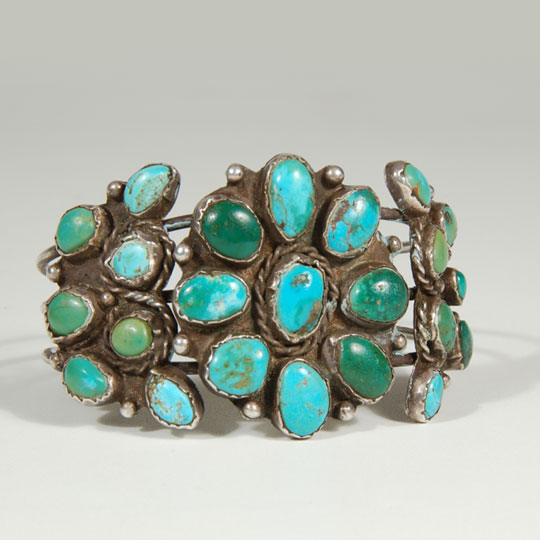 The foundation of this bracelet consists of three silver wires joined at their ends with a silver cross wire. The essence of the bracelet is the top which consists of three platforms with turquoise cabs in silver bezels.
The foundation of this bracelet consists of three silver wires joined at their ends with a silver cross wire. The essence of the bracelet is the top which consists of three platforms with turquoise cabs in silver bezels.
The center of the bracelet is a flower design of 9 beautiful turquoise cabs of varying shapes and color. Flanking this center medallion are arrangements of 7 turquoise cabs displayed in two rows. Each of these has turquoise stones of varying sizes, shapes and colors.
Navajo Sterling Silver Squash Blossom Earrings - 25889
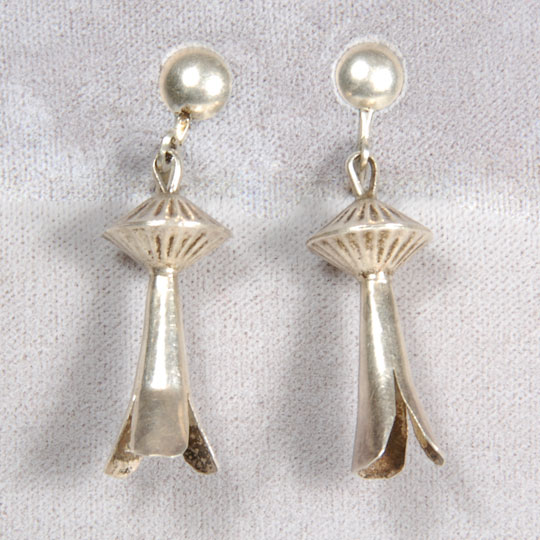 The Navajo learned silver working from the Spanish in the middle of the 19th century. One of the earliest designs they made was what is referred to as a "Squash Blossom." It resembles the blossom of a squash. The blossom that it was fashioned after was actually that of the pomegranate. The handmade blossoms of this pair of earrings dangle from sterling silver screw backs.
The Navajo learned silver working from the Spanish in the middle of the 19th century. One of the earliest designs they made was what is referred to as a "Squash Blossom." It resembles the blossom of a squash. The blossom that it was fashioned after was actually that of the pomegranate. The handmade blossoms of this pair of earrings dangle from sterling silver screw backs.
Sterling Silver and Turquoise Navajo-made Ring - 25888
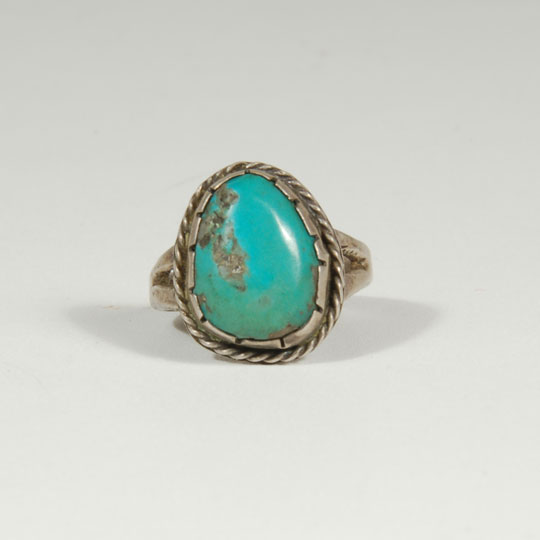 A beautiful green turquoise cab is securely held in place by a silver bezel that is sculpted around its edge. Around the bezel is a twisted silver wire rope. The ring is supported by a split shank silver band. It is these simpler silver rings that are the early ones. Later, it became popular to add silver adornments such as leaves around the stone. The simplicity of the early ones is responsible for their popularity.
A beautiful green turquoise cab is securely held in place by a silver bezel that is sculpted around its edge. Around the bezel is a twisted silver wire rope. The ring is supported by a split shank silver band. It is these simpler silver rings that are the early ones. Later, it became popular to add silver adornments such as leaves around the stone. The simplicity of the early ones is responsible for their popularity.

